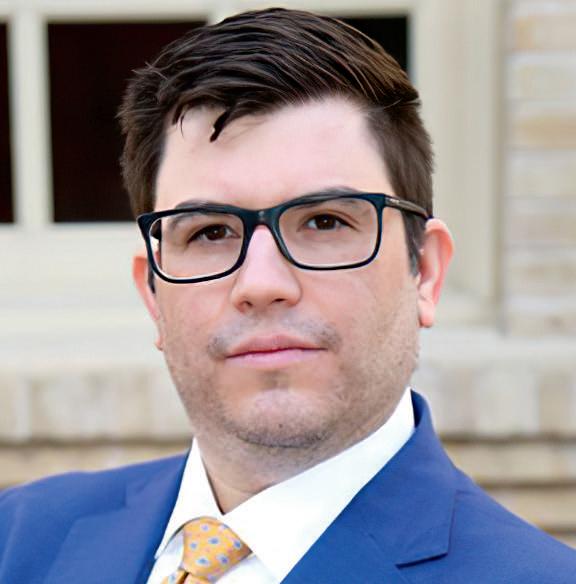
PAINTING THE PICTURE FOR THE APPELLATE RECORD




PAINTING THE PICTURE FOR THE APPELLATE RECORD


OFFICERS
TrishaMoralesPadia
President
AmandaI.Hernandez
VicePresident
IMMEDIATE PAST PRESIDENTS
MatthewAllen
RolandGarcia
JohnHunter
JosephEsparza
LoraineEfron
DonFlanary
MichaelMcCrum
PatriciaJay
WarrenWolf
RobertFeatherston
BOARD OF DIRECTORS
RolandoArguelles
JimBeethke
MacBozza
AnneBurnham
JonathanChavez
KarenCorby
DanielDeLaGarza
AndrewFroelich
ArleneGay
StevenGilmore
DIRECTORS EMERITUS
CharlesButts
AndrewFroelich
Secretary
DaynaJones
Treasurer
ZoeRussell
ExecutiveDirector
JorgeAristotelidis
JayNorton
MichaelGross
JeffMulliner
John“Bud”Ritenour
AdamKobs
GeorgeTaylor
StephanieStevens
JimGreenfeld
MichaelS.Raign
JohnA.Convery
ErnestAcevedo,III
RonaldP.Guyer
MarkStevens
GeorgeScharmen
CynthiaHujar-Orr
JessicaGonzalez
ValerieHedlund
AmandaHernandez
DaynaJones
StaciKrause
GuillermoLara
PatMontgomery
AngelaMoore
BryanOrihel
AdamPaltz
MaryPietrazek
MollyRoth
ElizabethRussell
ZoeRussell
ShawnSareen
ChristianVega
MeenuWalters
AnthonyNicholas
Ifyouwouldliketosubmitanarticletobeconsideredforpublicationin The Defender,orseeabouthowyoucanhelp orbecomeinvolvedwithandcontributeasanAssociateEditor,pleaseemaildaniel@delagarzacriminaldefense.com.
LETTER FROM THE PRESIDENT
TrishaMoralesPadia
LETTER FROM THE EDITOR
DanielDeLaGarza
ACCEPTANCE OF RESPONSIBILITY
AndrewFroelich
PRESERVATION OF ERROR
AllisonMathis
PAINTING THE PICTURE FOR THE APPELLATE RECORD
DaynaJones
CASE LAW UPDATE
RajK.Lahoti RocioMoncivais LucasOrlando
WRANGLING THE INTANGIBLES
MollyLizbethRoth
EDITOR-IN-CHIEF, DEFENDER
DanielDeLaGarza
DESIGNER, DEFENDER
JayDouglasRumisek JayRumisek@gmail.com
ASSOCIATE EDITORS, DEFENDER
DaynaJones GuillermoLara ZacheryMunoz
JasminOlguin
StephanieStevens
PHOTO CREDITS
All editorial images in public domain.


Astheincomingpresident,Iamhonoredand excitedtohavetheopportunitytoleadthis organization for the upcoming year. Throughout my career, I have been passionately dedicated to upholding justice and defending the rights of individuals, valuesweallholddearinourhearts.
As we embark on this journey together, I wanttoassureeachoneofyouthatmydoor isalwaysopen.Whetheryouhavequestions, comments,orconcerns,Iamheretolisten andsupportyouinanywayIcan.Together, we form a strong community of legal professionals committed to advocating for fairnessandequitywithinourcriminaljustice system.
I am truly excited about the opportunities and challenges that lie ahead of us. As I’m writingthis,it’sthefirstdayofspringwhich symbolizesnewbeginningsandgrowth.
I believe that we have the potential to cultivate positive change within our organizationandthebroaderlegallandscape ofSanAntonio.Letuscontinuetofightthe goodfight,standsteadfastinourmissionto upholdtheprinciplesofjustice,anddefend therightsofourclients.
Ilookforwardtoworkingcloselywitheach ofyouinthecomingyear,andIameagerto seewhatwecanaccomplishtogether.Letus nurture the seeds of progress and watch as theybloomintosomethingtrulyremarkable.
Thankyouforentrustingmewiththeroleof president. I am deeply grateful for the opportunity to serve this organization and oursharedmission.
Trisha Morales Padia SACDLA President

Figure it Out
Members,
IwasexcitedtotakethereinsfromMattAllen astheneweditor-in-chiefofTheDefender untilIwastoldIneededtowritealetterfrom theeditor.Iwaslike, how in the heck do I write a letter from the editor? I’veneverbeenaneditor,soI’veneverhadtowriteone.Idon’t know.
ItwouldhavebeeneasierformetosayIdon’t knowandletsomeoneelsedoit.Butsomuch ofwhatwedoinvolvesfiguringitout,soinsteadofleavingthisarduoustasktosomeone elseIfigureditout.Likeanycuriousperson, thefirststepwastofireupmyiPhoneandfind theansweronGoogle.Isearched“sampleletters from the editor” and found a bunch. Therewerebadones,severalgoodones,and afewgreatones.ThebadonesIdiscarded,the goodonesIre-readandtookafewideasfrom, andthegreatonesIusedtoeithercreatea
templateorfigureouthowtodevelopatheme forthisletter.Thelongandtheshortofitis,I figureditoutandnowyouhavethisbeautiful letterfromtheeditor.
Wefacethesameuncertaintyandapprehensioninourlawpractices.Therearetonsof thingsthataredifficultandarebetterleftfor someone else to figure out—like my letter fromtheeditor,forexample.Thecoordinator calledandsaidtoreportforimpactforvoir direin15minutesafteryourcasewasjustreset.ButI’mnotready,Idon’tknowhowtodo avoirdire.Figureitout.There’ssomeonein yourofficeandtheyhavealotofmoneyfor youtotaketheirlovedone’sappeal.ButI’ve neverwrittenanappellatebriefbefore.Take themoneyandfigureitout.Makesuretodo a great job for them too. The people who knowhowtodothisstuffweren’tbornwith theability.Theyfigureditout.
Theimportantthingtorememberisthatwith theexceptionofdevelopinglaw(i.e.COVID/
Zoom)andverynovellegalargumentsthat areprobablybestleftuptoGerryGoldstein— it’sallbeendonebefore.Whetherstandard motionsoranexampleofanappellatebrief, bythispointintimesomeone’sdoneitbefore. Don’treinventthewheel.Figureitoutby searching“samplemotiontosuppress”forexamplelikeIsearchedforsamplelettersfrom theeditor.You’llcomeacrossbadones,good ones,andgreatones.Discardthebadones. Takesomeideasfromthegoodonesandincorporatethemintothefinalproduct.Usethe greatonesasyourtemplate,thenaddyour factsand/orlegalanalysisandmakeityour own.Orbetteryet,logintoSACDLAand findthemotionsbank.You’llmostlikelyfind whatyouneedthere.Ifnot,there’stheListserv,oryourmentororbuddy.Whichever wayyoudoit,let’sgetitdone.Figureitout. Getthatthingfiled.Collectyourdismissalor getyourcasereversed.
Inthisissuewefeatureseveralexcitingarticles onerrorpreservation.Errorpreservationisan essentialskillforallgoodtriallawyersandis alwaysverymuchappreciatedbyanygood appellatelawyer.Asalawyerwhoregularly doesboth,IcansayIamconstantlylookingto constitutionalize my objections during trial
andcanonlyhopethetriallawyerhasdone thesamewhenI’mreadingarecordandwritinganappellatebrief.Wehopeatthevery least,thisissueprovidesabasicguideonhow topreservetherecordandwhenitshouldbe done.Wehavealsoincludedalegislativeupdateandawonderfulpoem.
Topicsforfutureissueswe’reconsideringincludegrandjurypackets,motionstodismiss, illegalsearchandseizure,andfederalmotion practice.Pleasereachoutifyouhaveanidea forafutureissueandasalways,pleaserememberweareconstantlyonthelookoutforhighqualityarticlesonanytopicrelatedtocriminal defense. Please, email your article to daniel@delagarzacriminaldefense.com to contribute.Itdoesn’tevenhavetobeedited; we’lldothatforyou.
Inclose,IfigureditoutandI’mveryexcited to take over as Editor in Chief of The Defender
Daniel De La Garza Editor-in-Chief The Defender
The San Antonio Defender isalwayslookingforcontentthatservestoinspire, educate,andexciteourmembership.Ifyouwouldliketocontribute,please contactamemberofthe Defender staff.

P.O. Box 831206
San Antonio, Texas 78283-1206
Telephone: (210) 501-2916
Facsimile: (210) 885-7714
*NAME: Mr. Mrs. Dr. Professor Other
First Name Last Name MI
MAILING ADDRESS: Street Address/Suite Nbr./PO Box City State ZIP County
TELEPHONE: FAX:
*EMAIL ADDRESS: _______________________________________________________________________
*TEXAS BAR CARD NO.: ________________________ DATE OF BIRTH: ________________________
Certified Criminal Law Specialist? YES NO
MemberofTCDLA? YES NO NACDL? YES NO
Do you want a Membership Certificate? YES NO
CATEGORY OF MEMBERSHIP: Contributing ($150 per year) St. Mary’s Law Student / First Year Lawyer ($30) Regular ($75 per year) St. Mary’s Crim. Law Assn. ($0, Volunteer 5 hours)
(Attorneys:) I am a member in good standing of the State Bar of Texas. I am actively engaged in the defense of criminal cases in the State, County or Municipal Courts in Bexar County or the surrounding contiguous Counties, or in the Federal Courts of the Western District of Texas. I do not hold a full time or elected Judicial or Prosecutorial Position.
*SIGNATURE: _____________________________________________
DATE: ________________
PLEASE MAIL APPLICATION TO: SACDLA, P.O. Box 831206, San Antonio, Texas 78283-1206
*Required Information (Bar Card No. not required for student membership application)


Andrew Froelich
“I’m sorry. I apologize. I accept full responsibility for my actions that brought me here and I promise not to do it again.”
These are words I use with my clients every day when they face sentencing fromajudge.I’vebeenacriminaldefense lawyerforoveradecade,andinmyexperiencethenumberonethingtheJudgewantsto hear from you is Acceptance of Responsibility.“IacceptthatImadeamistake.” “I’m sorry.” “It’s me. Hi. I’m the Problemit’sme.”(Thanks,TaylorSwift.) “I Fucked up, Judge.” (Don’t try this one at home,kids.)
Theevidencebacksthisup:accordingtoan articlein Journal of the American Academy of
Psychiatry and the Law Online,whenaperson expresses remorse, Judges perceive the Defendantas“lesslikelytorecidivateandto haveahigherpotentialforrehabilitation.Legalresearchhasdemonstratedthatremorseful defendantsaregenerallymorelikelytoreceiverelativelylenientpunishments,whereas remorselessdefendantsaremorelikelytoreceiveharsherpunishments.” So You’re Sorry? The Role of Remorse in Criminal Law Rocksheng Zhong, et al Journal of the American Academy of Psychiatry and the Law Online March 2014, 42 (1) 39-48.
IntheFederalsystemspecifically,Acceptance ofResponsibilityisatermusedthatmeans somethingVERYtechnical.Federalcriminal defendants can receive a reduction in their sentencesbyacceptingresponsibilityfortheir
actions. This means that your “Guideline Score,” which is a specific formula used by Federal Judges to determine a range for a Defendant’s sentence, changes based on whetherthatpersonacceptsresponsibilityfor theiractions.
Thereductioncanbetwoorthreepoints.As eachpointundertheU.S.FederalSentencing Guidelinesrepresentsthreetosixmonthsof incarceration, this reduction is extremely important to the overall amount of time served.
Whythough?Whyisitimportantthatwe acceptresponsibilityforouractionsandshow remorse?AccordingtotheFederalSentencing guidelines:
For several reasons, a defendant who clearly demonstrates acceptance of responsibilityforhisoffensebytaking, inatimelyfashion,theactionslisted above (or some equivalent action) is appropriately given a lower offense level than a defendant who has not demonstrated acceptance of responsibility.
However,thespecific“severalreasons”arenot identified,leavingustoguessastoWHYthe criminal justice system forces us to accept responsibilityandshowremorse?
IamwritingfrommyofficeinTexaswhere everydayIrepresentpeopleaccusedofcrimes ranging from sex offenses (rarely) to minor
crimes like failure to show ID to a police officer,orcriminaltrespass.TheonethingI havefoundisthatwhenItalktomylessexperiencedclients,theygenerallyacknowledge thattheywereinaplacetheyshouldnothave been,orthattheyputthemselvesinabadsituation.Now,theymaynotbeGUILTYof whattheyareaccusedof,buttheycanbear some
responsibilityorunderstandingofwhythey arethere.
Comparethattomyhabitualclients.Formy clientswhoarecontinuouslygettingarrested, whohavebeeninandoutofthecriminaljusticesystemforyearsandshownosignsof slowingdown,theNUMBERONEthingI seemostoftenisacompletelackofpersonal responsibility for any of their actions. It’s always someone else’s fault—the cop who arrested them, the alleged “victim” whose actionsREALLYcausedthecrimetohappen, soonandsoforth.Peoplewhoblameeveryoneandanyoneotherthanthemselvesand bearnoresponsibilityfortheirownsituations arethemostcommonfactorthatIseethat separates career criminals from people who make mistakes. Mistakes can be corrected, lessonscanbelearned,butaperson’soverall mindsetismuchmoredifficulttochange.
This article is intended to educate and entertain. It is NOT legal advice or opinions and reflects only the author’s general view of criminal cases. Do NOT take this as legal advice. IF you want legal advice, please hire a lawyer familiar with the individual facts of YOUR case.




There are two types of trial attorneys, I feel:trialattorneyswhoaredoingtheir besttopreserveerror,andtrialattorneys whoareineffective.Ifthatsoundsharsh,you areprobablyinthesecondcategory.Butdon’t worry,gentlereader,wecandosomething about that! And what we can do is endeavor to preserve error wherever and wheneverwecan.
Truthfully,Ithinkmosttrialattorneysdocare alotaboutpreservingerror,buttheproblem ismorethattheydon’tknowhowtodoitand theystrugglewithbeingabletocomeupwith whattheyneedtocomeupwithwhenthey needtocomeupwithit.Thoughthatstruggle isneverentirelyover(whichiswhywe“prac-
tice”law,anddon’tever“perfect”it),hereisa handykitofcaselawandpointerstohelpyou feellessatsea.
Tex.R.AppP.33.1governspreservationfor appeal.
The record must show that the objectionstatedthegroundsfortherulingthatthecomplainingpartysoughtfromthetrialcourtwith sufficient specificity to make the trial court aware of the complaint, unless the specific grounds were apparent from the context.” Tex. R. App. P.33.1(a)(1)(A).
Rule33.1providesthatinordertopreservea complaintforappellatereview,apartymust havepresentedtothetrialcourtandobtained arulinguponhistimelyrequest,objectionor motion,statingthespecificgroundsforthe rulinghedesiredthecourttomakeifthespecificgroundswerenotapparentfromthecontext. Long v. State, 800 S.W.2d 545 (Tex.Crim. App. 1990).
Oneyoungtrialattorneyofmyacquaintance thoughtthatallobjectionshadtofitintoa grid of typical objections. “I thought there wereonlyabout10objectionsyoucoulduse,” shesaid,“andyoujusthadtofitinwhatever youthoughttheproblemwasintooneofthe mainobjections.”Notso,infact,theopposite istrue.
Whenyoufeelsomethingiswrong,youneed togetuprightnowandtalkitout.
Tobetimely,anobjectionmustbelodgedas soonasthepartyknowsorshouldknowthat theerrorhasoccurred.Lackey,364S.W.3dat 843.
Defensecounselmustobjecttoinadmissible testimony, improper argument, or any claimedirregularityattheearliestpossibleopportunityandthefailuretodosoconstitutesa waiverofthecomplaint. Mendez v. State, 138 S.W.3d 334 (Tex.Crim.App. 2004). A motion formistrialbasedonaState’switnessalluding
toextraneousoffensesinviolationofamotion in limine was not timely when it was not madeuntilafterthewitnesshadtestifiedabout the extraneous offenses without objection. Griggs v. State, 213 S.W.3d 923 (Tex.Crim.App. 2007).
Itdoesn’tneedtobesomemagicalformula,or analgebraicequation.Infact,youshouldtry tobeasclearandplain-speakingaspossible:
“Asregardsspecificity,allapartyhastodoto avoidtheforfeitureofacomplaintonappealis toletthetrialjudgeknowwhathewants, whyhethinkshimselfentitledtoit,andtodo soclearlyenoughforthejudgetounderstand him at a time when the trial court is in a properpositiontodosomethingaboutit... [Appellatecourts]shouldreachthemeritsof thosecomplaintswithoutrequiringthatthe partiesreadsomespecialscripttomaketheir wishesknown.” Lankston v. State, 827 S.W.2d 907, 909 (Tex.Crim.App. 1992) (emphasis added).
ThisiskindoflikeJeopardy!Ifyouwatchthe really competitive players, you notice that sometimestheybuzzinbeforetheyactually knowexactlywhatthey’regoingtosay,trusting their sense of recognition and recall to kickinbythetimetheyhavetoactuallysay the answer. Objections are the same way. Standup,say,“Objection,YourHonor,”and if you’re not entirely sure what it is that’s wrong,askforpermissiontoapproach,think whileyoushuffleyourpapers,andthentalkit out.Ofcourse,theremaybestrategicreasons
youwantthejurytohearyourobjection,or thatyoudon’twanttoapproach.Generally, thoseobjectionsareshorterandlesscomplex andyouknowwhatyou’regoingtosaybeforeyoustandup(forexample“leadingthe witness”).
The important thing is that the COURT knowswhatyou’resayingandisabletorule onit.
“Ratherthanfocusonthepresenceofmagic language,acourtshouldexaminetherecord todeterminewhetherthetrialcourtunderstoodthebasisofadefendant’s[objection].” State v. Rousseau, 396 S.W.3d 550 (Tex.Crim. App. 2013).
Thegenerallyacknowledgedpolicyofrequiringaspecificobjectionistwo-fold.First,a specific objection is required to inform the trialjudgeofthebasisoftheobjectionand affordhimtheopportunitytoruleonit. Martinez v. State, 22 S.W.3d 504 (Tex.Crim.App. 2000).Second,aspecificobjectionisrequired toaffordopposingcounselanopportunityto removetheobjectionortosupplyothertestimony. Zillender v. State, 557 S.W.2d 515 (Tex. Crim.App. 1977).
and objectEVERYtimetheStateattemptstointroduce evidence of an extraneous offense: Toogeneral:“irrelevant,”“prejudicial,”“had nothing to do with the facts of the case.”
Chatham v. State, 646 S.W.2d 512 (Tex.App.— Dallas 1983, pet ref’d).
Sufficiently specific: Inherently prejudicial and raises the possibility that the jury will convict the accused because he or she is a criminal generally. Williams v. State, 662 S.W.2d 344 (Tex.Crim.App. 1983).Forcesthe accusedtodefendhimselfagainstchargesof which he had no notice. Ford v. State, 484 S.W.2d 727 (Tex.Crim.App. 1972). Confuses theissuesandincreasesthepossibilitythata jurywillconvictoninsufficientevidence.
IfyoucanbringitbacktotheConstitution, youaregoingtogetamorebeneficialharm analysisonreview,youarehopefullygoingto scarethetrialcourtintolisteningtowhythis isabigdeal,andyouarewinningmajorsmart pointswiththejury/yourclient.
TRAP 44.2Reversible Error in Criminal Cases.
(a)Constitutional Error.–If the appellate recordinacriminalcaserevealsconstitutional errorthatissubjecttoharmlesserrorreview, thecourtofappealsmustreverseajudgment ofconvictionorpunishmentunlessthecourt determines beyond a reasonable doubt that theerrordidnotcontributetotheconviction orpunishment.
(b)OtherErrors.–Anyothererror,defect,irregularity, or variance that does not affect substantialrightsmustbedisregarded.
“Ifwetreatedobjectionssuchasthosemade byAppellantasraisingadueprocessclaim,a convictionorsentencecouldbecompletely overturnedbasedonwhatappearstobeanevidentiaryruling.Thecourtneedstobepresentedwithandhavethechancetoruleonthe specificconstitutionalobjectionbecauseitcan have such heavy implications on appeal.” Clark v. State, 365 S.W.3d 333, 340 (Tex. Crim. App. 2012)
Clarkisaprettyinterestingcasebecausethe Appellanttestifiedattrialandthendidn’tlike thewaytheprosecutortalkedtohimduring crossexamination. Id. at 334.Shocker.The prosecutor,tobefair,stoodup,yelled,and pretty aggressively questioned him while holdingagunthatwasinevidence.Youguys. Pleasetellmeyouwouldhavesaidsomething tothattoad.Defensecounselobjectedtobadgering and argumentative questions, but didn’t constitutionalize them by saying, “HEY!Thisisadueprocessviolation.Thisis impedingmyclient’srighttoafairtrial.”Because,youknow,itwastrue.Buthedidn’tsay that.
Wheretrialcourtordersexclusionofmembersofthepublicfromthecourtroom,anobjectionthattheruling“istoobroadtoexclude thedefendant’swifeanddaughter”doesnot preserveerrortothedenialoftherighttoa publictrial. Peyronel v. State, 465 S.W.3d 650 (Tex.Crim.App. 2015). Bring it back to the constitution!
WherethedefendantclaimedthattheState improperlydestroyedevidencepriortotrial butdidnotputthetrialjudgeonnoticethat theTexasConstitutionprovidesgreaterprotectionthantheUnitedStatesConstitution, thisclaimwasnotpreservedforreview. Pena v.State, 285 S.W.3d 459 (Tex.Crim.App. 2009). Thecourtlaterheldthatthedefendanthad preservedaBradyclaiminhismotionfornew trial because the issue was sufficiently clear fromtherecordmadeatthemotionfornew trialhearingeventhoughtheword“Brady” wasnotspecificallyusedinthemotion. Pena v. State, 353 S.W.3d 797 (Tex.Crim.App. 2011).
Keepgoinguntilyougetoverruled!
Aftervoicingatimelyandspecificobjection, defensecounselmustthenpursuethematter tothepointofsecuringanadverseconclusory rulingfromthetrialcourt. Tucker v. State, 990 S.W.2d 261 (Tex.Crim.App. 1999).Thismeans askingforaninstructiontodisregardifthe objectionissustainedandmovingforamistrial if an instruction to disregard is given. Nethery v. State, 692 S.W.2d 686 (Tex.Crim.App. 1985).Whilethebetterpracticeistoobtainan expressruling,thetrialcourtmayimplicitly ruleonamotion. Gutierrez v. State, 36 S.W.3d 509 (Tex.Crim.App. 2001); see also Leal v. State, 469 S.W.3d 647 (Tex.App.– Houston [14th Dist.] 2015, pet. ref’d) (trial court implicitly overruled motion to suppress).
Becauseanobjection,instructiontodisregard, andrequestformistrial“seekjudicialremedies of decreasing desirability for events of de-
creasingfrequency,thetraditionalandpreferredprocedureforapartytovoiceitscomplainthasbeentoaskfortheminsequence [but]thissequenceisnotessentialtopreserve complaintsforappellatereview.Theessential requirementisatimely, specific request that the trial court refuses.” Young v. State, 137 S.W.3d 65 (Tex.Crim.App. 2004).
Ifyoureceiveacurativeinstruction,youmust pressthetrialcourttoanadverserulingby movingforamistrial,andthefailuretodoso willprecludeappellatereviewofyourcomplaint. Duran v. State, 505 S.W.2d 863 (Tex. Crim.App. 1974).
Thetrialcourtmaynotprohibitcounselfrom preserving error by threatening him with contempt. Ruiz-Angeles v. State, 351 S.W.3d 489 (Tex.App.– Houston [14th Dist.] 2011, pet. ref’d).WhileIthinkit’sreasonablyuncommonforjudgestotrytoholdlawyersincontemptforpreservingarecord,thedialogue thatgoesonbetweentheCourtanddefense counselinRuiz-Angelesstartsoutprettyfamiliar.
THE COURT: Do we have everybody’s strikes?
MR.WATHEN:No.
THECOURT:Youwillnotapproachagain. SurrenderyourstrikestotheBailiff,andwe willgetthistrialforward.Mr.Wathen,thisis aClassCMisdemeanor.Turninyourstrikes now.
MR.WATHEN:Iobject.
THECOURT:Getitdown.
MR.WATHEN:WilltheCourtnotallow metomaketherequiredMotion?
THECOURT:TheCourtwillnotputup withanymoredelayingstrikes.
MR. WATHEN: Object and move for a Mistrial.
THECOURT:GiveyourstrikestotheBailiff now.
MR. WATHEN: I need two moments to writethemdown.
THECOURT:Youweregivenalistoftheir names,sothatwouldnotbenecessary.
MR.WATHEN:MovefortheCourttoinstructthejurorstodisregardalltheCourt’s remarks.
THECOURT:Turnoveryourstrikesnow. (Jurorschosen)
MR. WATHEN: Renew my Motion for a Mistrial.CanIgetarulingonmyMotionfor aMistria1?
THECOURT:Motionisdenied.Mr.Wathen,ifyoucontinueyourdilatorytactics,I willholdyouinContempt.Iwilldeclarea Mistrial,butyouwillbeheldinContempt.
MR.WATHEN:MayIrenewmyobjection, YourHonor?
THECOURT:Haveaseat.Anyobjections tothepanel?
MR. WATHEN: Yes, Your Honor. May I approach?
THECOURT:Youcanmakeyourobjection whereyoustand.
MR. WATHEN: Defense objects that DefenseisnotallowedtomakehislegallyrequiredMotionforpreemptorychallenges.
THECOURT:Denied.
Id. at 5.
Ithinkit’simportanttonoticethatthedefense attorneywasreallypersistenthere,andtheappellatecourtthoughtsotoo,indicatingthathe hadessentiallypreservedtherecordenough forappellatereviewevenwhilebeingthreatenedwithcontempt. Id.Ithinkthatprobably interactionslikethishappenmorethanwerealize, but defense counsel is not persistent enoughtopushthejudgeintosayingwhat they’rethinking—whichis“quitwastingmy time, your client is guilty and this doesn’t matter.” That’s actually what the court in Ruiz-Angelesendedupdeciding,bytheway, thattheissuethatdefensewassodesperately tryingtopreservedidn’treallymatteranyway, butitwasafightworthpicking,anditwas importantthathemadethejudgesaythequiet partoutloud.Thelessonhereistokeeppushingtoareasonableextent—don’tgetthrown injail,butmakearecord.
Itisalwaysgoingtobeeasiertofileawritten motionthantomakeaspokenobjection.I’d muchratherhavethetimetosit,think,and reflectonwhatI’msayingthantojusthaveto flybytheseatofmypants.That’sabigpartof thereasonweneedtobefilingspecificlimine motionsaheadoftrial.ThereasontheState filesliminemotionsinEVERYcaseisbecause theywork.Weneedtodothesame.Unlike theState,though,weneedtomakeourmotionstailoredtothecaseathand,andnota
boilerplatenightmare.
A limine motion itself is necessary but not sufficient.
Thepurposeofamotioninlimineistoprevent particular matters from comingbefore thejuryandis,inpractice,amethodofraising objectiontoanareaofinquirypriortothe matterreachingtheearsofthejurythrougha posed question, jury argument, or other means.Itiswiderinscopethanthesustaining ofanobjectionmadeaftertheobjectionable matter has been expressed. Norman v. State, 523 S.W.2d 669 (Tex.Crim.App. 1975).Because ofthat,thegrantingofapre-trialmotionin liminewillnotbyitselfpreserveerrorandfor errortobepreservedwithregardtothesubjectmatterofthemotioninlimine,soitisabsolutelynecessarythatanobjectionbemade atthetimewhenthesubjectisraisedduring trialandanadverserulingsecuredfromthe trialcourt. Martinez v. State, 98 S.W.3d 189 (Tex.Crim.App. 2003)
Alsofileaspeedytrialdemand!
Ithinkthatfilingspeedytrialdemandsshould beroutineinmostcases(therearesome,of coursethatstrategydictateswedon’tactually wantspeedytrialson,butinthemajorityof cases,weneedtobepushingforit—mostof thetimeitisgoingtobeharderfortheState togettheirstufftogetherthanitisforus.
Error preservation requirements apply to SixthAmendmentclaimsthatthedefendant hasbeendeniedherrighttoaspeedytrial. Henson v. State, 407 S.W.3d 764 (Tex.Crim.App. 2013).
Andmakethejudgedosomewriting,too:
Upontimelyrequestbythelosingparty,the trialjudgemustprovideexplicitessentialfactualfindingssupportingthegrantingordenial of a motion to suppress. State v. Cullen, 32 S.W.3d 853 (Tex.Crim.App. 2000). “Essential findings” means that “the trial court must makefindingsoffactandconclusionsoflaw adequatetoprovideanappellatecourtwitha basisuponwhichtoreviewthetrialcourt’s applicationofthelawtothefacts.” State v. Copeland, 501 S.W.3d 610 (Tex.Crim.App. 2012).Intheabsenceofsuchwrittenfindings, theappellatecourtwillviewtheevidencein thelightmostfavorabletothetrialjudge’srulingandassumethatitmadeallimplicitfactual findingsthatsupportitsrulingsolongasthey are supported by the record. See Aguirre v. State, 402 S.W.3d 664, 667 (Tex.Crim.App. 2013)(Cochran, J., concurring in the refusal of discretionary review)(defense counsel’s failure to obtain findings of fact “sealed appellant’s fate on appeal.”).
You can ask for findings on other rulings, you’rejustnotentitledtothem.Somejudges don’tknowthat.Ithinkthatpractically,asking for the reasoning behind the ruling is something we should pretty routinely do. Askingforthereasoningontherecordand askingforwrittenfindingsissomethingthat signalstothejudgethatyou’regoingtobe takingthemuponthisrulingandmaybethey oughttoconsideritabitmorecarefully.
Preservingerrorataplea:
Ohman,don’tbethisguy.Mooreentered intoapleaagreementfor28yearsonadrug charge.Thejudgeacceptedthepleaandtold himtocomebacklaterforsentencing.Then, whenMoorefailedtoappearatsentencing, thejudgedecideditwasanopenpleanow, andsentencedhimto40years.Becausehe
didn’tobjectormovetowithdrawhisguilty plea,the court let that stand. I know. I KNOW. See: Moore v. State, 295 S.W.3d 329, 333 (Tex. Crim. App. 2009).
Changinggears,let’sassumeyou’renotobjectingtothebadstufftheStateisgettingin, you’re trying to get some stuff in yourself. TheStateobjects,thejudgesustainstheState’s objection.Nowit’stimeforyoutoputonthe evidenceanywayinanofferofproof.
Whenyouputonanofferofproof,thisis kindofyoursecondbiteattheapple.Though whatyou’redoingismakingarecordforthe appellate court to consider, the other thing you’redoingishelpingthetrialjudgeunderstandwhyyouthoughtthiswasrelevantevidenceinthefirstplaceandtryingtogetherto changehermind.
“Whenthetrialcourtexcludesevidence,the partyofferingitshallhavetheabsoluterightat anytimebeforethecourt’schargeisreadto thejury,tobeallowedtomakeanofferof proofintheformofaconcisestatementinthe absence of the jury.” Moosavi v. State, 711 S.W.2d 53 (Tex.Crim.App. 1986). Defense counselisnotlimitedtoanyonemethodof showingwhattheexcludedtestimonywould havebeen, See Gutierrez v. State, 764 S.W.2d 796 (Tex.Crim.App. 1989),andsolongasthe offerofproofputsthetrialjudgeonnoticeas towhatheisexcluding,itissufficienttopreservethematterforappellatereview. Love v. State, 861 S.W.2d 899 (Tex.Crim.App. 1993); Williams v. State, 116 S.W.3d 788 (Tex.Crim. App. 2003).Thetrialcourtmaynotrestrict defensecounsel’sabilitytomakeanofferof proofonrelevancyormaterialitygroundsand where the accused is denied this right, the
causemustberemandedtothetrialcourtso thatanunfetteredofferofproofcanbemade. Spence v. State, 758 S.W.2d 597 (Tex.Crim.App. 1988).
Asthepartyofferingtheevidence,thedefendantisnotrequiredtotellthetrialcourtwhy hisevidenceisadmissible,onlythatitisadmissible. Cameron v. State, 241 S.W.3d 15 (Tex. Crim.App. 2007) (emphasis added).
IftestimonyonyourDIRECTEXAMINATIONisrestricted:Defensecounselmustfirst object to the trial court’s exclusion of the profferedtestimonyandsecureanadverseruling from the court. Moosavi v. State, 711 S.W.2d 53 (Tex.Crim.App. 1986). Defense counsel must then make a concise offer of proofastowhattheexcludedevidencewould haveshownhaditbeenadmitted. Tatum v. State, 798 S.W.2d 569 (Tex.Crim.App. 1990).So longastheofferofprooffairlyapprisesthe trialcourtastothenatureoftheevidenceitis excluding,theofferofproofissufficient. Guiterrez v. State, 764 S.W.2d 796 (Tex.Crim.App. 1989)
IfyourquestionsforyourCROSSEXAMINATION are restricted: After objecting to thetrialcourt’slimitationandsecuringanadverserulingfromthecourt,defensecounsel mustmakeanofferofproofastothequestions hewouldhaveaskedandtheanswerswhich hemighthavereceived. Koehler v. State, 679 S.W.2d 6 (Tex.Crim.App. 1984).Itisnotnecessaryfordefensecounseltoshowthathiscrossexaminationwouldhaveaffirmativelyestablishedthefactshesoughttoprove. Hurd v. State, 725 S.W.2d 249 (Tex.Crim.App. 1987).
In Goodman v. State, 701 S.W.2d 850 (Tex.Crim.App. 1985), theCourtofCriminalAppealsheldthatarun-
ning objection did not preserve error on a matterreferredtobyanywitnessatanytime during the course of the trial, a view later notedwithapprovalbytheElPasoCourtof Appealsin Mares v. State, 758 S.W.2d 932 (Tex. App.—El Paso 1988, pet ref’d).Butin Moreno v. State, 755 S.W.2d 866 7 (Tex.Crim.App. 1988), theCourtheldthatdefensecounsel’srunning objection to this line of questioning was sufficienttopreserveerror.Andinafootnote in Sattiewhite v. State, 786 S.W.2d 271 (Tex. Crim.App. 1989),theCourtagainheldthatdefensecounsel’srunningobjectionwassufficient to preserve error when all the parties wereawareofthenatureofthetestimonyat issue. In Ethington v. State, 819 S.W.2d 854 (Tex.Crim.App. 1991),theCourtheldthata runningobjectionissufficienttopreserveerrorsolongasdefensecounseltakespainsto makesurethattherunningobjectiondoesnot encompasstoobroadareachofsubjectmatter overtoobroadatimeoroverdifferentwitnesses.
Sowhatdoesthatmean?Youcanmakearunningobjection,butitdoesn’tmeanverymuch andyoushouldn’trelyonitbyitself.Thinkof itlikealiminemotion,kindoftheframework butnotthewholehouse.
Evenifyouhaveinitiallypreservederrorafter the prosecutor engages in misconduct, you mustrenewyourobjectionifandwhenthe prosecutoragainengagesinthesameorsimilarargumentortheerrorinthefirstinstance willbewaived. McMahon v. State, 582 S.W.2d 786 (Tex.Crim.App. 1978).
Ihavepracticedinalotofjurisdictionswhere
benchtrialsweremuchmorecommonthan theyarehereinTexas.Ithinkthatbench trialsprobablyshouldbemorecommonthan theyareinTexas,thoughofcoursethereare alotofstrategic,case-specificexceptionsto that.Still,incasesthatinvolvethingsthat jurorsaresqueamishabout,judgesare sometimesabletobelessemotionallyreactive andunderstandlegalnuance.Sometimes. AndinthistimeofCOVID,Ithinkbench trialsareprobablyconsiderablybetterthana lotofthejurytrialoptions,ofcourse, dependingonthejudge.
Inabenchtrial,stricttimelinessofacomplaint “maynotbequite‘ascrucial’”becauseajudge, inthecapacityaslegalarbiter,ispresumedto beabletodisregardthosemattersthejudge deems to be inappropriate for the judge to consider in the separate role as factfinder. Id.(quotingGarza v. State, 126 S.W.3d 79, 83 (Tex. Crim. App. 2004));seealso Quick v.State, 557 S.W.3d 775, 787-88 (Tex. App.—
Houston [14th Dist.] 2018, pet. filed) (noting that courts have been more lenient and flexible regardingerrorpreservationin abenchtrialbecause the timing of an objection does not matter if thetrialcourt still has an opportunity to make[**12] a ruling on the objection, but a complaint about closing argument not made until a motion for newtrialwas untimely). Bell v. State, 566 S.W.3d 398, 405 (Tex. App. 2018).
So,yougotthat?Maybe?Ifnothingelse,I thinkthekeytakeawaysfromthisfornewer practitionersshouldbethese:trustyourinstincts,standupandtalkthroughyourobjection,andbringitbacktotheConstitution wheneveryoucan.Ihaveaseriesofminiature sticky-notesIputinmytrialnotebookwith basicconstitutionalconceptsandkeywords onthemforwhenmybrainisreallyscrambling.Butthat,dearfriends,isalessonforanotherday.
The San Antonio Defender isalwayslookingforcontentthatservestoinspire, educate,andexciteourmembership.Ifyouwouldliketocontribute,please contactamemberofthe Defender staff.

Against All Odds
August 9, 2024
Central Jury Room
Nuts & Bolts
October 11, 2024
Central Jury Room



“Did the children ever sleep in this room? (Attorney indicating on diagram).”
“What about that room?
“What about over here?”
Readingthroughatranscriptandseeingthese types of questions is confusing, frustrating, andcouldbedamagingtoyourclientonappeal.Consideringthelineofquestioning,I canonlyassumethatthewitnessistestifying thatthevictiminthissexualassaulttrialnever sleptintheroomwheresheclaimedshewas
assaulted,butmyassumptionisnotclearin therecord.
Ifyouarepointingatademonstrativedrawingandaskingthewitness,“Didthechildren eversleepinthisroomthathasbeenidentified asmyclient’sbedroom?”Or,“Whataboutthis roomthatisacrossthehallandidentifiedas Cindy’sbedroom?”Thesesmallchangesdo notchangethesubstanceofthequestion,but they absolutely tell the appellate audience whereyouarepointingonthedemonstrative.
Distancesalsocomeupalotincasesandmany timesintheappellaterecordIread,“Washe thisfaraway?Oralittlefarther?”Ifdistanceis importanttothecase,thenestablishingthe
distancesintherecordisalsoimportantfor appeal.Aneasywaytoaskthequestionscould be,“Washethisfaraway?”andifthewitness agrees,“Doyouagreethatdistanceisabout10 feet?”
Beingatriallawyerisdifficult.Youareworriedabouttellingthestoryofyourcase,listening for the appropriate time to object, and constantlyhavingtothinkonyourfeet.But makingtherecordclearonappealiscritical forachanceatasuccessfulappeal.
Andappellaterecordsareblackandwhite— wedon’tgetseethewitness’sdemeanor,hear theirtone,orknowwhethertheywerekind, rude,oremotional.Ilovereadingonarecord whenoneoftheattorneysasksawitnesswho isbeinghostileoraggressiveabouttheirtone anddemeanor—ifit’sappropriate.
“Your honor, I move to admit Defense Exhibits 11 and 12 into evidence?”
“State, any objections?”
“Yes, your honor. We object that the documents are not relevant and contain hearsay.”
“Sustained. Defense counsel come retrieve your documents.”
Ifthesedocumentsarenotapartoftheappellaterecordbecausedefensecounselfailedto makethemapartoftherecordfortheappeal, thenthereisprobablynoissuetoraiseonappeal.Whenexhibitsyouwanttoadmitget excludedfromtherecord,youneedtomake anofferofproofinordertopreserveerror “unlessthesubstancewasapparentfromthe context.” Tex. R. Evid. 103(a).
Anofferofproofissimpleandmustbedone togetexcludedevidenceandtestimonyinto therecordandpreserveerror.Justbecausethe judgeexcludedportionsofyourcase,doesnot meanthatthejudgemadethecorrectruling. Asimplewaytomaketheofferofproofisat thetimethejudgeisexcludingtheevidence, simplysay,“Iwouldliketomakeanofferof proofoftheevidenceyouareexcluding.”A lotoftimesthejudgewillsay,“Youcando thatonabreak.”Onthenextbreak,gospeak intotherecordinaconcisestatementwhatthe evidenceortestimonywouldhavebeen,why itwasimportanttoyourcase,andadmitany exhibitsintotherecordasoffersofproof.“The courtmustallowapartytomakeanofferof proof as soon as practicable.” Tex. R. Evid. 103(c).
Ifthejudgeisexcludingtestimony,youmay stillspeakintotherecordwhatthetestimony wasgoingtobe,however,ifapartyrequests thattheofferofproofbeinquestion-and-answerform,thecourtmustrequirethatyou questionthewitnessoutsidethepresenceof thejuryinordertomaketheofferofproof. Tex. R. Evid. 103(c).
Painting the picture into the record and addingtheexcludedevidenceintotherecord asanofferofproofsothattheappellateattor-
neysandjudgeswhowillbedecidingthecase have a full picture of trial will help your client’schancesonappeal.
MAC JimBethke
CLE Committee
ShawnSareen
Monthly CLEs
ShawnSareen
Fiesta CLE
JohnConvery/MarkStevens
Brady Bunch
JohnHunter/ZoeRussell
Awards Committee RolandGarcia
Membership Committee ArleneGay
Social Committee/ Holiday Party RolandoArguelles
Technology Committee StaciKrause
The San Antonio Defender isalwayslookingforcontentthatservesto inspire,educate,andexciteourmembership.
Ifyouwouldliketocontribute,pleasecontact amemberofthe Defender staff.



Raj K. Lahoti


Hinojosa v. State, No. 04-22-00401CR (Tex. App. – San Antonio Jan. 10, 2024)(not designated for publication).
AjuryconvictedDavidHinojosaofmurder, andhewassentencedtothirtyyearsinprison. Onappeal,Hinojosacontestedtwoprimary issues:First,thetrialcourt’srefusaltogranta mistrialaftertheprosecution’sclosingremarks accusedhisdefensecounseloflyingaboutsurveillance video evidence; second, the trial court’sdecisiontoallowamugshotforidentification,whichhearguedwasunfairlyprejudicialandsuggestiveofunrelatedcriminal
behavior. The appellate court found no reversibleerrorwascommittedonbothissues andaffirmedthetrialcourt’sruling.
Duringhisclosing,theprosecutorallegedthat thedefensecounselliedaboutwhatsurveillancevideosshowed.Inassessingtheappropriateness of the prosecutor’s statement, the FourthCourtconsideredwhethertheprosecutor’sargumentfelloutsidethefourpermissibleareas:summationoftheevidence,reasonable deduction from the evidence, an answertotheargumentofopposingcounsel,
or a plea for law enforcement. Hawkins v. State, 135 S.W.3d 72, 80 (Tex. Crim. App. 2004).
Theappellatecourtclarifiedthatanargument that“strikesatadefendantovertheshoulders ofdefensecounsel”isoutsidepermissibleareas andthusconstitutedanimproperargument. Davis v. State, 329 S.W.3d 798, 821 (Tex. Crim. App. 2010).
Thenextstepwastoassesswhethertheimproperargumentwascurableandifthetrial court employed effective curative measures. TheFourthCourtconsideredtheargument’s curability,notingthatthejuryhadaccessto thedisputedvideoevidenceandcouldmake theirassessment.Theprosecutor’sfailureto repeatorinsistontheaccusationoflyingwas anotherfactorindeterminingcurability.The trialcourt’sswiftinstructiontothejury(however, not in the strongest terms of “must,” “should,”or“will;”butintheformof“can”)to disregardthestatementandclarificationthat theprosecutor’sstatementsarenotevidence, were considered the curative measures needed.
Finally,followingtheprecedentsetin Jackson v.State, 927 S.W.2d 740, 744 (Tex. App.— Texarkana 1996),theFourthCourtevaluated theimpactoftheimproperargumentonthe jury’sverdict.Thecourtconcludedthatthere wasnoreasonablepossibilitythattheprosecutor’scommentcontributedtothejury’sverdict.Thisconclusionwasbasedonthejury’s abilitytoindependentlyreviewthevideoevidencecentraltothedisputedcomment.
Theappellatecourtexplainedthatthelegal
principles governing the admission of mug shotsinatrialarenotstraightforward.Amug shot can be admissible and carry probative value, especially in establishing a witness’s ability to identify the defendant. Hajjar v. State, 176 S.W.3d 554 (Tex. App.—Houston [1st Dist.] 2004); Wood v. State, 18 S.W.3d 642 (Tex. Crim. App. 2001).However,theadmissionof amugshotcouldbeprejudicialifitimplied committing an extraneous offense or infringedonthedefendant’srighttothepresumptionofinnocence. Araiza v. State, 929 S.W.2d 552 (Tex. App.—San Antonio 1996); Richardson v. State, 536 S.W.2d 221 (Tex. Crim. App. 1976). The admissibility of mug shots wasdescribedasaquestionofdegree,withthe photograph’s admissibility depending on whetheritimpliesapolicerecord.Araiza,929 S.W.2dat555.
Theappellatecourtconsideredwhetherthe mugshot“tendedtoshowthecommissionof anextraneousoffense”andunfairlyprejudiced thejuryagainstHinojosaandnotedthatHinojosa’sidentityastheshooterwasnotdisputed,butthestatewasstillrequiredtoprove identity as an element. The appellate court concludedthattheprejudicialeffectofHinojosa’smugshotfromapreviousarrestoutweigheditsprobativevalue,makingitsadmissionanabuseofdiscretion.
Despitefindinganerrorinadmittingthemug shot, the appellate court undertook a harm analysistodetermineiftheerroraffectedHinojosa’ssubstantialrights.Basedonthecumulationandstrengthofthestate’sevidence, includingthesurveillancevideoandwitness testimonies,theappellatecourtconcludedthat theerrordidnothaveasubstantialandinjuriouseffectorinfluenceonthejury’sverdict. Therefore,Hinojosa’ssubstantialrightswere
notaffected,leadingthecourttooverrulehis secondpointoferror.
Davis-Pittman v. State, No. 04-2200408-CR, (Tex. App.–San Antonio, December 27, 2023)(not designated for publication).
A jury convicted Davis-Pittman of misdemeanorassault-bodilyinjuryforassaultinghis girlfriend.Evidencepresentedatthetrialincludeddissectinga911callmadebythedefendant’saunt,whoinitiallyreportedwitnessing the assault but later gave less clear testimony.Thecallrevealedanongoingaltercationandsuggestedthepresenceofphysical violence. The responding officers provided descriptionsofthegirlfriend’sinjuries,noting rednessandswellingindicativeofarecentassault.Photographicevidencepresentedinthe trialcourtvisuallysupportedtheofficers’accounts. Additionally, Davis-Pittman’s testimonyincludedanadmissionofphysicalcontactwiththecomplainant,whichcontributed to the trial court’s conclusion that the evidence supported the conviction. DavisPittman’s defense challenged the legal and factualinsufficiencyofthisevidence.
TheFourthCourt,citingtheBrooksvState, 323S.W.3d893,opinioninabolishingthe factual-sufficiency review as it applies to criminalconvictions,declinedtoaddressthe factual insufficiency argument raised by Davis-Pittman.
Inaddressingthelegalinsufficiencyclaim,the FourthCourtfoundallelementsweresupportedbysufficientevidence.Still,itreiteratedthatthestateisnotrequiredtoprovethe exactmannerandmeansoftheassault.Thisis becauseassaultisaresult-orientedoffense. Bin Fang v. State, 544 S.W.3d 923, 929 (Tex. App.—
Saxon v. State, No. 04-22-00744CR, (Tex. App. – San Antonio, De- cember 20, 2023) (not designated for publication).
Afterbeingfoundguiltyoffelonyassaultona family member and sentenced to ten years confinemen,suspendedforeightyearsofprobation,Saxonappealedthejudgmentarguing thetrialcourterredwhenitallowedapunishmentphasewitnesstobepresentduringthe guilt-innocencephaseofhistrial.Although TexasRuleofEvidence614,“theRule,”was invoked,theStatesoughtpermissionforthe witnessofaseparateallegedassaulttobeallowedinthecourtroomthroughoutthetrial. ThetrialcourtoverruledAppellant’sobjectionsandallowedthepunishmentwitnessto remaininthecourtroomduringtheguilt-innocencephaseofthetrial.
Theappellatecourtassumed,butdidnotdecide,thatthewitnessmetthestatute’sregimentstobeexemptandinsteadfocusedon harm.Primarily,thecourtreasonedthepunishmentwitnesshadfocusedhertestimonyon herpendingsexualassaultcase,shedidnot contradictnorsupportevidencepresentedin trial,andwascalledafterthejuryhaddeterminedguilt.TheFourthCourtheldthetrial courtdidnotcommitreversibleerrorbyallowing the punishment witness to testify whenshehadbeenpresentduringthetrial.
Ex Parte Luis Alexis GonzalezMorales, No. 04-22-00629-CR, (Tex. App. – San Antonio, December 20, 2023) (not designated for publication).
Luis Alexis Gonzales-Morales appealed the trialcourt’sorderdenyinghimhabeascorpus reliefonthedismissalofhiscriminalcharges. AfterAppellantwasarrestedinWebbCounty fortrespassingonprivateproperty,hefiledan applicationforwritofhabeascorpustodismissthesecharges.Appellantarguedthatthe state was engaging in selective prosecution and thus violated his Texas Constitution’s Equal Rights Amendment and the United StatesConstitution’sEqualProtectionClause. Specifically,hearguedthatthestatewasonly prosecutingmenwithmisdemeanorcriminal trespassandnotwomen.
Thetrialcourtheldahearingwhereitheard testimonyfromtheStateTrooperwhohad arrestedAppellant,alongwithfourothermen and one woman, for criminal trespass. The State Trooper testified that the men were takentothetemporarydetentioncenterand thewomanwasreleasedtoU.S.BorderPatrol. Headmittedthiswastheusualsituationfor casesrelatedtoOperationLoneStar(OLS).
Thetrialcourtalsoheardtestimonyfroma memberoftheLubbockPrivateDefender’s Office(LPDO),whotestifiedthatshewasunaware of any women being prosecuted for criminaltrespassaspartofOLS.Shealsostated shewasunawareofanyWebbCountycases where women were charged with criminal trespass.
Thestaterespondeditsactionsserved“important governmental objectives,” but failed to providesupportingevidence.Ultimately,the trialcourtdeniedappellant’srequestforrelief. This habeas proceeding happened concurrentlyandfollowedthesameargumentsasEx
parte Vasquez-Bautista, No. 04-22-00630CR,__S.W.3d__,(Tex.App.—SanAntonio Dec.6,2023,nopet.h.)(enbanc).
Toestablishaprimafacieclaimofselective prosecution,Appellantmusthaveshownthe prosecutorial policy “had a discriminatory effect”and“wasmotivatedbyadiscriminatory purpose.” Id. (quoting Wayte v. United States, 470 U.S. 598, 608 (1985)).Here,Appellantmethisburdenandshowedtheprosecutorialpolicyhadadiscriminatoryeffectand purpose.
UndertheTexasEqualRightsAmendment, thestateissubjecttostrictscrutinyandmust showitsdiscriminatoryconductisjustified, narrowlytailored,andservedacompellinginterest.Thestatearguedthatthelargeinfluxof undocumentedimmigrantsposedadangerto safetyandpublichealth.TheFourthCourt rejected the state’s arguments and held the trial court abused its discretion in denying AppellantreliefundertheTexasEqualRights Amendment.
Underthefederalequalprotectionclaim,the stateissubjecttointermediatescrutiny.The Statemustshow“theclassificationservesimportantgovernmentalobjectivesandthatthe discriminatorymeansemployedaresubstantiallyrelatedtotheachievementofthoseobjectives.” Id. (quoting Ex parte Aparicio, 672 S.W.3d at 715 and Miss. Univ. for Women v. Hogan, 458 U.S. 718, 724 (1982)).Theappellatecourtheldthetrialcourtabuseditsdiscretion in denying Appellant relief under the federal equal protection claim and reversed thetrialcourt’sorderandremandedthecase withinstructionstodischargehimfrombail anddismisswithprejudice.
The Fourth Court of Appeals reached the sameconclusionintwomoreOperationLone Star Cases. See Ex parte Vasquez-Marquez, No.04-22-00626-CR(Tex.App.–SanAntonioDec.27,2023);ExparteAntonio-Santiago,No.04-22-00628-CR(Tex.App.–San AntonioDec.27,2023).
Small v. State No. 04-22-00463-CR (Tex. App-San Antonio, December 13, 2023) (not designated for publi- cation).
Onappealfromaconvictionformurder,Appellantraisedtheissuethatthetrialcourterred infailingtoinstructthejuryonthelesserincluded offenses of manslaughter and criminallynegligenthomicide.Whenreviewinga trial court’s refusal to submit a Lesser-IncludedOffense(LIO)instruction,thereviewingcourtwilllookforanabuseofdiscretion. Chavezv.State,666S.W.3d772,776(Tex. Crim.App.2023).ThetestforwhetheradefendantisentitledtoaLIOinstructionisa two-parttest.Id.Thefirsttestistocompare theelementsoftheallegedlesseroffensewith theelementsofthegreateroffenseandanyallegationsintheindictment.Id.Here,thestate conceded that manslaughter and criminally negligent homicide are lesser included offensesofmurder,resolvingthefirsttest.The secondtestisthattheremustbeevidencefrom whicharationaljurycouldfindthedefendant guiltyofonlythelesseroffense.Chavez,666 S.W.3dat776.Thesecondtestismetonly“if there is evidence that directly refutes or negates other evidence establishing the greateroffenseandraisesthelesser-included offenseorthereisevidencethatissusceptible
todifferentinterpretations,oneofwhichrefutes or negates an element of the greater offenseandraisesthelesseroffense.”Ritchersonv.State,568S.W.3d667,671(Tex.Crim. App.2018).Atrialjudge’sjobunderthesecondprongistoconsidertheevidenceanddeterminewhetheritissufficienttosupportsubmission of a LIO instruction. Chavez, 666 S.W.3dat778.
Appellantarguedthathedidnotintendto shootthecomplainantinthebackofthehead, andinsteadcontendedthattherewasevidence showingthathehitthecomplainantwithhis gun,andasaresult,thegunaccidentallyfired. TheFourthCourtagreedthatAppellanthit thecomplainantwithhisgunonthebackof the head, but disagreed that the evidence showed that the gun was accidentally fired duringoneoftheseblows.Instead,theFourth Court noted there was no evidence in the record,otherthanargumentsbycounsel,that supportedtheappellant’stheorythatthegun wentoffaccidentally.TheFourthCourtreiteratedthat“meredisbeliefofevidenceestablishingcommissionofthegreateroffenseis insufficientbyitselftojustifysubmissionofa LIOinstruction.Thisisbecausethedisbelief of evidence is not evidence.” Chavez, 666 S.W.3dat777.TheFourthCourtfoundthat therewasnoaffirmativeevidenceofafactual disputethatraisedthelessoroffenseandrebuttedornegatedotherevidenceestablishing thegreateroffense.Thus,theFourthCourt ruledthatthetrialcourtdidnotabuseitsdiscretionbyfailingtosubmitinstructionson thelesser-includedoffensesofmanslaughter andcriminallynegligenthomicidetothejury.
Appellantalsoarguedthatthetrialcourterred inpermittingtheStatetoimproperlycommentontheapplicationofparolelawduring thepunishmentphaseofhistrial.Duringclos-
ing argument, the prosecution improperly urgedthejurytoconsiderparoleandparole eligibilitywhenthejuryassessedtheappel-

Raj K. Lahoti is in his third year at St. Mary’s University School of Law. Mr. Lahoti is a student attorney for the St. Mary’s Criminal Justice Clinic and is graduating in August 2024 with a Juris Doctorate. Raj is a licensed Professional Engineer with the State of Texas, currently advancing his legal education as a part-time student while working full time as an engineer. Raj anticipates utilizing his engineering background and legal expertise to practice in environmental and natural resources law upon graduation.

is a third-year law student at St. Mary’s University School of Law. She is currently a student attorney for the Criminal Justice Clinic at the Center for Legal and Social Justice. After graduating from law school, she will pursue a career as a criminal attorney, where she trusts
lant’ssentence.However,Appellant’scounsel didnotobjectatthetimeandthus,noerror waspreservedforreview.
God will open doors to help others. One of her main goals is to help stop human and child trafficking in the United States and abroad.

Lucas Orlando is a third-year law student and a long-time research nerd. Lucas has spent the majority of his time in law school diving deep into case law. He served as a research assistant to Professor Johnson his first year of law school before joining the Dean’s Research Fellows. He hopes to put his research skills into practice in clinic and beyond.
I’msittingonaroundsilvercircleinsideajailcellinasilencepiercedwithdistantbangs
Thedoorslammedandlockedbehindmeaminuteago
Icanpressabuttonandaguardletsmeout,butnotnow
Nowwebothmustmeet
Willmeet
Meetwhenhecomesintothelockedboxconnectedtomylockedbox
Nobuttonletshimout
Quickbreath
Swellsofsmellsofdecadesofsweatandmoldanddisintegrationofcementandmetal
Shufflethroughmypapersquickly,quickly–whenwasheaccusedofwhat?
Where’smypen?
Shuffle,order,shuffle,order
Gotit
IknowwhatIhavetosay
Breath
HowdoI hear whatImust hear?
Quietagain,distantbanging
Metalslams
Metalslamslouder
Nowtherearefootprints Click!Slam!Click!
Rattle,rattle,rattle
Chainssliding
Bothstanding
Bothsitting
Firstjudgmentsthroughthescreen
Stares
Deepslowbreath
Itbeginswithstares
Herewego
Keepbreathing

P.O. Box 831206
San Antonio, Texas 78283-1206
Telephone: (210) 501-2916
Facsimile: (210) 885-7714
*NAME: Mr. Mrs. Dr. Professor Other
First Name Last Name MI
MAILING ADDRESS: Street Address/Suite Nbr./PO Box City State ZIP County
TELEPHONE: FAX:
*EMAIL ADDRESS: _______________________________________________________________________
*TEXAS BAR CARD NO.: ________________________ DATE OF BIRTH: ________________________
Certified Criminal Law Specialist? YES NO
MemberofTCDLA? YES NO NACDL? YES NO
Do you want a Membership Certificate? YES NO
CATEGORY OF MEMBERSHIP: Contributing ($150 per year) St. Mary’s Law Student / First Year Lawyer ($30) Regular ($75 per year) St. Mary’s Crim. Law Assn. ($0, Volunteer 5 hours)
(Attorneys:) I am a member in good standing of the State Bar of Texas. I am actively engaged in the defense of criminal cases in the State, County or Municipal Courts in Bexar County or the surrounding contiguous Counties, or in the Federal Courts of the Western District of Texas. I do not hold a full time or elected Judicial or Prosecutorial Position.
*SIGNATURE: _____________________________________________
DATE: ________________
PLEASE MAIL APPLICATION TO: SACDLA, P.O. Box 831206, San Antonio, Texas 78283-1206
*Required Information (Bar Card No. not required for student membership application)

